An intriguing feature was observed during the examination of Michael Sweerts’ Peasant Family with a Man Defleaing Himself (collection Mauritshuis, see fig. 1). The composition shows six figures in an Italianate landscape with a barn. On the right, a woman and a girl are depicted, standing with their back to the viewer. The upper body of the woman is depicted against the background sky, and interestingly the paint of the sky directly adjacent to the figure displays a slightly lighter tone creating a halo-like pale shape around the mother. Surprisingly, infrared reflectography revealed the contradictory presence of a carbon-rich (and thus dark) layer below the paint surface. Sweerts applied a dark grey halo to block out the contours of the main figures in the early stages of the painting process.
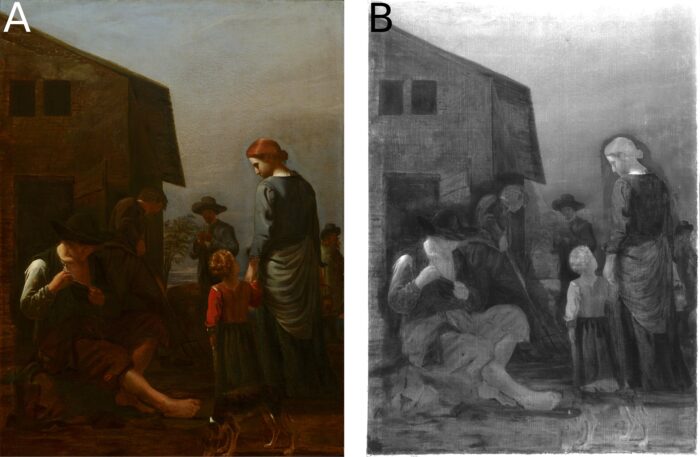
Once aware of this phenomenon of dark halos, one can see it in many more 17th-century Dutch and Flemish paintings. Many dark halos are visible to the naked eye, both in unfinished paintings like Peter Lely’s Portrait of James II when Duke of York (collection National Portrait Gallery), and finished works like Jan Steen’s The Ill Woman (collection Rijksmuseum). Most halos are found outlining human figures, and most often the faces of these figures (see fig. 2). Nevertheless, some artists also applied halos along the contours of animals or inanimate objects. Examples are Frans Francken the Younger’s Art Cabinet with Scholars around a Globe (Private collection) and Pieter Codde’s A Painter in his Studio Tuning a Lute (Private collection), in which halos can be found around the dog and the cello respectively (see fig. 3).
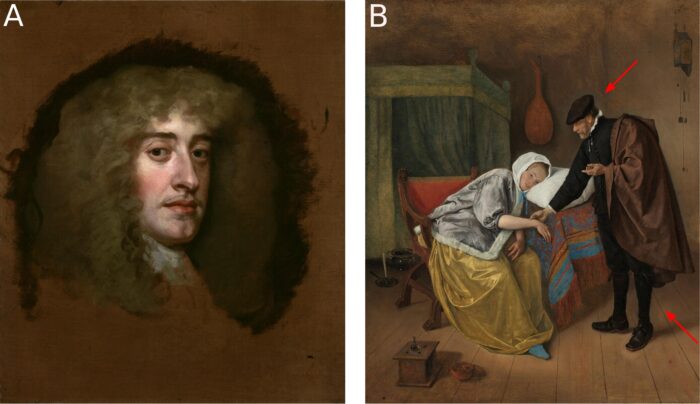
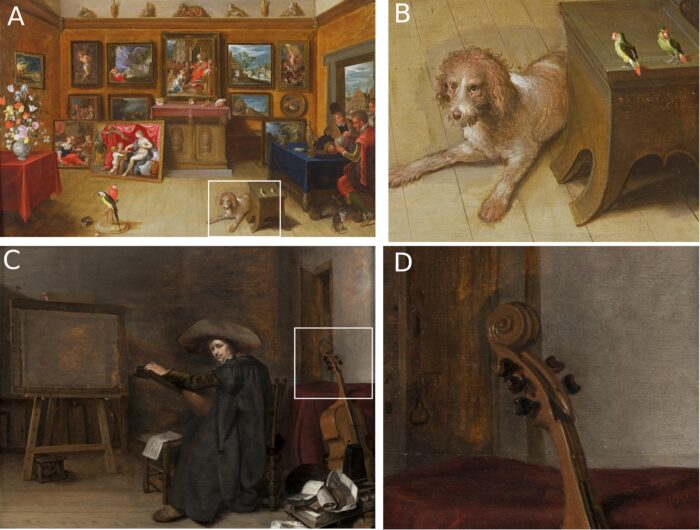
Not all halos are readily visible to the naked eye. Imaging techniques, like infrared photography/reflectography and MA-XRF scanning*, can help visualize more halos. Infrared examination of Anthony Van Dyck’s paintings at the National Gallery London revealed dark halos in several paintings, including his portrait of Lord John Stuart and his Brother, Lord Bernard Stuart (collection National Gallery London, see fig. 4). Underlying halos can only be detected using infrared examinations if they are rich in carbon-based pigments and to a lesser extent earth pigments. The typical build-up of 17th-century paintings often proves unfavorable for distinguishing halos using infrared reflectography, as both the preparation layers and the paint layers on top often contain similar pigments. This is where MA-XRF scanning may come in handy: this technique is sensitive towards halos potentially containing other pigments.

MA-XRF scanning revealed the presence of many more (dark) halos in the oeuvre of Michael Sweerts. MA-XRF examination of his A Game of Draughts revealed more halos, rich in potassium, iron, manganese, and lead (see fig. 5). These were not visible in the infrared reflectography due to the pigment composition of the halos, but with the more sophisticated imaging technique it was possible to visualize them.
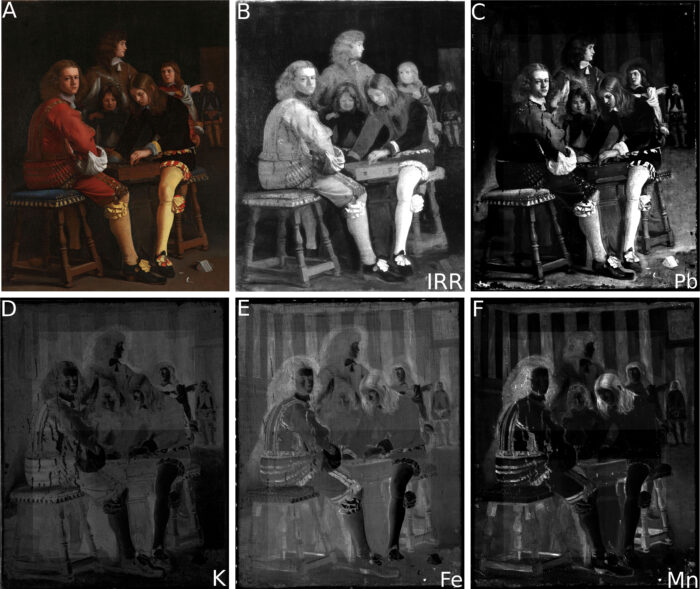
As is clear from all the above, halos can be found in a substantial number of 17th-century Dutch and Flemish paintings, including many works by Michael Sweerts. This raises the question as to the function of this ‘dark halo technique’. This is a topic that hasn’t received much attention in the art historical literature. Ella Hendriks supplied a plausible theory that I will expand on in the context of the oeuvre of Sweerts: she rationalized the technique as a way to ‘provide a foil against which the tones of the portrait could be established’. This means that it was easier for an artist to paint the correct flesh tones after he/she applied a dark halo first: the dark halo thus serves as a color reference in the early painting stage.
It appears that by introducing the (dark) halo technique, artists intuitively or empirically found a solution to optical phenomena that were only described much later. In 1839, Michele Eugène Chevreul demonstrated that our eye will exaggerate the difference between two colors when we look at them simultaneously: he called this optical effect the simultaneous contrast effect. This effect is a way for us to better distinguish two colors, as they will appear to us as dissimilar as possible. In modern optics and visual perception studies, scholars have also discussed the so-called ‘ring condition’ in the context of simultaneous contrast. Adding a (dark grey or black) ring around the target object is an effective way to reduce or even abolish the simultaneous contrast effect (see fig. 6). The dark halo technique may be how 17th-century painters tried to deal with the simultaneous contrast effect.
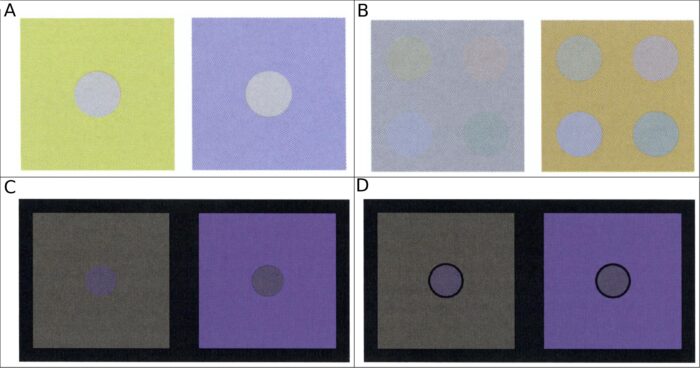
Upon returning and taking a closer look at the paintings that initiated this study, it seems likely that creative artists like Sweerts adapted the dark halo technique for their own specific needs and situations. In Sweerts’ oeuvre, halos were only found in paintings made during his Italian sojourn (c. 1646 – c. 1656). So far, no halos have been found in the works he made in the Low Countries. The difference between his Italian and Netherlandish works is the ground layers used to prepare his canvases. In the Low Countries, Sweerts worked on canvases prepared with a grey (upper) ground, while in Italy he worked on intense reddish brown grounds. It must have taken quite the effort to understand and anticipate the optical effects of the underlying warm color when switching from grey to reddish-brown grounds. Did Sweerts use the dark halo technique to be able to deal with the reddish brown ground better?
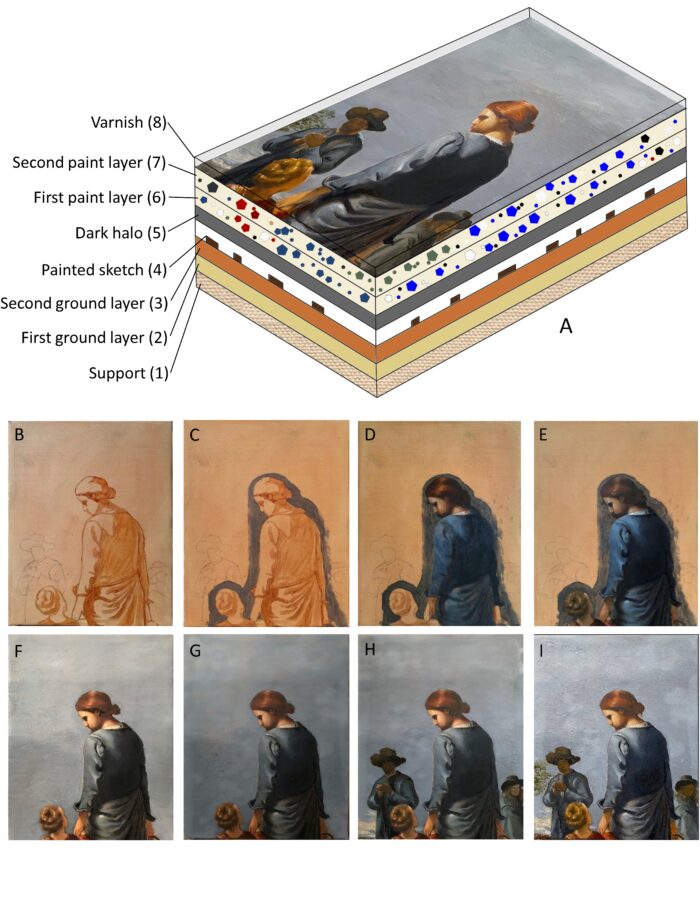
Master’s student Markha Youchaeva (University of Antwerp, Conservation and Restoration of Paintings) carried out reconstructions of Sweerts’ Peasant Family to test the hypothesis and to better understand how the dark halo technique works. Markha made one reconstruction of the painting without the dark halo, and one including the dark halo (see fig. 7). After the completion of each reconstruction, the findings were discussed. After finishing the reconstruction without the dark halo, Markha mentioned difficulties determining the right flesh tones as well as the correct blue color of the woman’s dress. She mentioned having applied the highlights in the skin tones initially too pale, and the shaded areas of skin color too dark. After the blue sky was filled in, the skin tones appeared too orange. When making the reconstruction with the dark halo technique, Markha noted less difficulties with the skin tones. These results seemed to confirm our hypothesis that the strong reddish-brown ground layer does have a severe influence on our perception of the first applied colors.
For 17th-century painters, the dark halo technique may have had several functions. Sweerts saw in the painting technique an efficient and novel tool to diminish the simultaneous contrast effect caused by the strongly colored grounds that he had to deal with during his Italian sojourn.
* MA-XRF imaging is an analytical imaging technique based on X-ray fluorescence. More on this technique and how it works can be found here and here.
The above is a condensed version of a chapter from my dissertation, which is titled “Scanning Michael Sweerts and Michaelina Wautier. Uncovering the working methods of 17th-century Brussels artists by means of MA-XRF examination”.
Want to read more?
- Kirsten Derks et al., “The dark halo technique in the oeuvre of Michael Sweerts and other Flemish and Dutch baroque painters. A 17th c. empirical solution to mitigate the optical ‘simultaneous contrast’ effect?”, in: Heritage Science 10:5 (2022).
- Kirsten Derks et al., “Reconstructing Sweerts: Practical Insights into the Historical Dark Halo Technique based on Paint Reconstructions”, in: Anne Dubois (ed.), Alla maniera: Technical Art History and the Meaning of Style in 15th to 17th Century Painting (Underdrawing and Technology in Painting Symposia 22) 2024, pp. 259-272.
- V. Ekroll and F. Faul, “Basic Characteristics of Simultaneous Color Contrast Revisited”, in: Psychological Science 23:10 (2012), pp. 1246-1255.